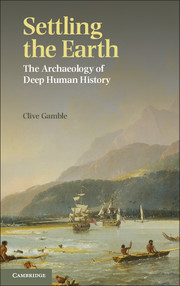Book contents
- Frontmatter
- Dedication
- Contents
- List of boxes
- List of figures
- List of tables
- Acknowledgements
- Glossary
- Web resources for skulls and stone tools
- 1 The worlds of deep human history
- 2 The drivers of climate and environment: Terrae 0–2, 10Ma–50ka
- 3 The recent veneers of climate, environment and population: Terrae 3–5, 50ka to the present day
- 4 Walking and running down the tectonic trail: Terra 0, 10–3.3Ma, and Terra 1, 3.3–1.8Ma
- 5 Three strides across a bio-tidal world: Terra 2, 1.8Ma–50ka
- 6 Going beyond, keeping in touch: Terra 3, 50–4ka
- 7 The call of the north: Terra 3, 50–4ka
- 8 Eyes on the horizon: Terra 4, 4–1ka
- 9 The human reunion in retrospect: Terra 5, after 1400 AD
- Bibliography
- Index
7 - The call of the north: Terra 3, 50–4ka
Published online by Cambridge University Press: 05 June 2014
- Frontmatter
- Dedication
- Contents
- List of boxes
- List of figures
- List of tables
- Acknowledgements
- Glossary
- Web resources for skulls and stone tools
- 1 The worlds of deep human history
- 2 The drivers of climate and environment: Terrae 0–2, 10Ma–50ka
- 3 The recent veneers of climate, environment and population: Terrae 3–5, 50ka to the present day
- 4 Walking and running down the tectonic trail: Terra 0, 10–3.3Ma, and Terra 1, 3.3–1.8Ma
- 5 Three strides across a bio-tidal world: Terra 2, 1.8Ma–50ka
- 6 Going beyond, keeping in touch: Terra 3, 50–4ka
- 7 The call of the north: Terra 3, 50–4ka
- 8 Eyes on the horizon: Terra 4, 4–1ka
- 9 The human reunion in retrospect: Terra 5, after 1400 AD
- Bibliography
- Index
Summary
The movement of humanity, arising from a countless series of actions arbitrarily performed by many individuals, is a continuous phenomenon
Leo Tolstoy, War and Peace, 1869The Granary and Treasury Routes to Expansion
The model of global settlement inspired by archaeogenetic studies points to delay. Beginning 80ka molecular years ago, humans began to disperse throughout Africa and the South Asian part of Terra 2. A southern route to Sunda was favoured. But then came a lengthy pause followed by a second wave of dispersals in the same and new directions, Sahul being the first. The human settlement of northern latitudes, the subject of this chapter, took place at various times after 50ka (Figure 6.1).
Delay is also a feature of the archaeological evidence for later dispersals. There were, as we saw in Chapter 5, technological and cultural changes within Africa during Terra 2 (Figure 5.5) regarded by many archaeologists as evidence for “behavioural modernity” (Box 6.1). But these did not become part of a clear-cut archaeological signature indicating human dispersal outside that continent. Elsewhere in Terra 2, and particularly in South Asia, humans using Mode 3 stone artefacts passed through older hominin populations with a similar technology. As a result, the archaeological traces of their movements are cloaked, their earliest expansion along the southern route unaccompanied by a trumpet blast of new things to herald the arrival of ourselves – the modern human – onto a world stage. Indeed, as we saw in the last chapter, the arrival of humans in Sahul was a muted affair, even though getting there had immense significance. However, the clearest indication that something momentous had happened in human deep history is not provided by a creative outburst of new technology and aesthetic products of the imagination. Instead, it is signalled by the range of ecologically tough habitats they settled soon after their arrival. Change, which involved an amplification of some sort, had occurred.
- Type
- Chapter
- Information
- Settling the EarthThe Archaeology of Deep Human History, pp. 227 - 278Publisher: Cambridge University PressPrint publication year: 2013



